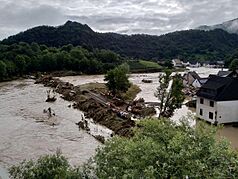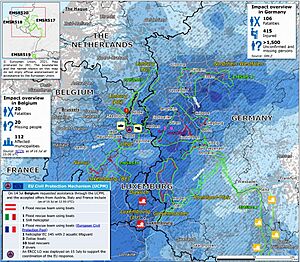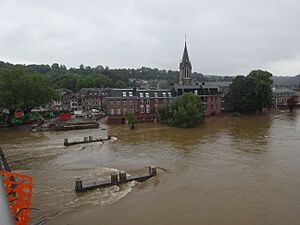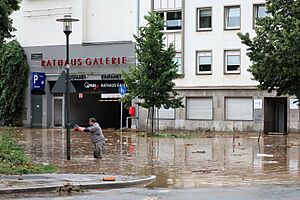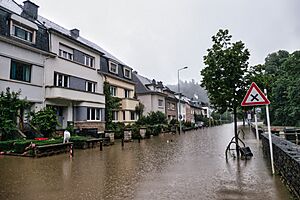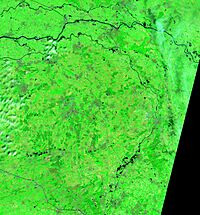2021 European floods facts for kids
|
|
|
| Date | 12–25 July 2021 |
|---|---|
| Location |
|
| Deaths | 243
|
| Property damage | €54 billion (2021 Euro)
|
In July 2021, many countries in Europe faced very bad floods. These floods caused many deaths and a lot of damage. The flooding began in the United Kingdom with sudden, heavy rains. These rains caused some damage to homes and made things difficult.
Later, the floods spread to many river areas across Europe. Countries like Austria, Belgium, Croatia, Germany, Italy, Luxembourg, the Netherlands, and Switzerland were affected. At least 243 people died in these floods. This included 196 people in Germany and 43 in Belgium.
Belgian Minister of Home Affairs Annelies Verlinden called it "one of the greatest natural disasters our country has ever known." German minister-president Malu Dreyer from Rhineland-Palatinate state said the floods were "devastating." The floods also caused power outages and forced many people to leave their homes. Roads, bridges, and farms were badly damaged. Scientists, activists, and reporters later pointed out that these floods were linked to extreme weather patterns. They said that heavier rainfall is becoming more common due to climate change.
Contents
Understanding the Weather Events
Between July 12 and 15, 2021, very heavy rain fell across the United Kingdom, western Germany, and nearby countries. These included the Netherlands, Belgium, and Luxembourg. A large storm system moved from France into Germany and stayed over the region for two days.
Record Rainfall in Europe
The rain was very intense in eastern Belgium. For example, the town of Jalhay received 271.5 mm (10.7 inches) of rain in just 48 hours. This is almost three times the normal amount for July. In Spa, 217 mm (8.5 inches) of rain fell in 48 hours.
Heavy rain also hit southern North Rhine-Westphalia and northern Rhineland-Palatinate in Germany. These areas saw 100 to 150 mm (3.9 to 5.9 inches) of rain in 24 hours. This is like getting more than a month's worth of rain in one day. Some places, like Reifferscheid, had 207 mm (8.1 inches) of rain in nine hours. The city of Cologne saw 154 mm (6.1 inches) in 24 hours. Some affected regions might not have seen this much rain in 1,000 years.
Flood Warnings
The European Flood Awareness System (EFAS) gave warnings about dangerous floods beforehand. These warnings were sent to national authorities.
Impact Across Countries
The floods caused different problems in each country. Here's how some areas were affected.
Austria
On July 17, a sudden flood hit Hallein, a town near the German border. Rescue teams in the states of Salzburg and Tyrol were ready for more flooding. Chancellor Sebastian Kurz said that heavy rains were causing serious damage. Sadly, one person died in Saalbach-Hinterglemm during the floods.
Belgium

On July 15, people in the city of Liège (about 200,000 residents) were told to leave. This was because the Meuse river was close to overflowing, and a dam bridge might collapse. No cars were allowed into the city center, only out. By July 16, other smaller towns in Limburg Province also had to evacuate.
Many homes in Liège and Namur provinces lost clean tap water. This happened because fuel tanks broke loose and leaked into rivers. About 41,000 homes in Wallonia lost electricity. Buildings near rivers collapsed because their foundations were washed away. In Pepinster, at least 20 houses fell down. The town of Verviers was also badly hit, and over 10,000 residents had to move.
The heaviest rain in Belgium was in Jalhay, with 271.5 mm (10.7 inches) in 48 hours. This was a new record for Belgium. In Spa, 217 mm (8.5 inches) of rain fell in 48 hours.
A train went off its tracks at Grupont because floodwater washed away the ground under the rails. Many railway lines in southeastern Belgium were closed. It was expected to take weeks to fix the damage to the rail network. Farms and animals had to be moved, and many fields were damaged. The Circuit de Spa-Francorchamps race track also had damage to its roads. Belgian Prime Minister Alexander De Croo declared July 20 a national day of mourning.
On July 24, southern and central Belgium were hit again by sudden floods. This was due to strong thunderstorms. The city of Dinant was badly affected, with many cars floating and damaging railway lines.
Croatia
The Slavonia region in Croatia also experienced floods. Towns like Našice and Osijek were flooded. Heavy rain caused serious damage, especially for farmers. No deaths were reported in Croatia.
Czech Republic
Heavy rain caused floods, especially in North Bohemia. Several towns near Česká Lípa had to be evacuated. The country offered emergency help to those affected by the floods.
France
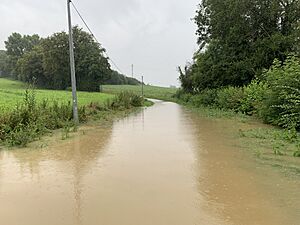
According to Météo-France, a lot of rain fell in France between July 12 and 16. For example, 199 mm (7.8 inches) of rain fell in Châtel-de-Joux. No deaths were reported in France.
Germany
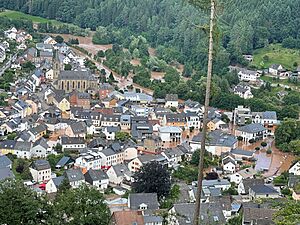
With at least 184 deaths, these floods were the deadliest natural disaster in Germany since 1962. At first, 1,300 people were reported missing. This was mainly because cell phone networks were down. It was unlikely that so many people had died. Police, soldiers, and emergency workers helped with search and rescue.
Most deaths were in Rhineland-Palatinate (135 people) and North Rhine-Westphalia (47 people). Four firefighters also died. Many homes lost power, and it was hard to fix things because roads were blocked. The German Weather Service said that some areas had the most rain in over 100 years. Some places got a month's average rainfall in one day.
Ahrweiler District Devastation
The district of Ahrweiler in Rhineland-Palatinate was one of the worst-hit areas. The Ahr river rose very high, destroying many buildings and causing at least 110 deaths. The shape of the Ahr valley, with its narrow sections, made the heavy rain even worse. This was the worst flooding here since 1910.
On July 14, the city of Hagen declared a state of emergency. The village of Kordel was completely cut off. Several rivers reached their highest levels ever. For example, the Kyll river rose from 1 meter (3.3 feet) to 7.85 meters (25.8 feet).
Transport and Infrastructure Damage
Train services to Germany were stopped. Deutsche Bahn said that over 600 km (370 miles) of train tracks were damaged in North Rhine-Westphalia. Many train lines were closed. The train connection from Dresden to Prague was also stopped due to mudslides. Along the Ahr Valley Railway, at least seven railway bridges were destroyed.
In Blessem, floodwaters from the Erft river flooded a quarry. This caused a big landslide, and some buildings collapsed. Part of the nearby highway also broke away. Experts worried that the Steinbachtal Dam was unstable. About 4,500 people were moved from parts of Euskirchen as a safety measure. Drones checked the dam, and while no cracks were found, the situation remained "critical." Another dam near Wassenberg burst, leading to more evacuations. About 360 prisoners had to be moved from a prison near Euskirchen. In Eschweiler, over 300 patients from a hospital had to be evacuated.
Strong rain also caused floods in Baden-Württemberg and Saxony. On July 17, more heavy rain caused flooding in Saxony and Bavaria. One person died in Bavaria. The flooding damaged the Königssee bobsleigh, luge, and skeleton track. It will take a long time to rebuild it.
Italy
On July 14, storms reached Northeastern Italy. They damaged farms and roads. In Trentino-Alto Adige, a fallen tree damaged a cable car. In Veneto, one person died.
Luxembourg
In Luxembourg, hundreds of people had to leave their homes in Echternach and Rosport. Many homes in Mersch lost electricity. A camping ground in Rosport was quickly evacuated. Emergency shelters were set up for people who had to leave their homes.
Netherlands
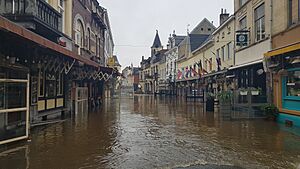
In the Netherlands, the town of Valkenburg aan de Geul was hit hardest. Streets in the town center were flooded, and people in care homes had to be moved. King Willem Alexander and Queen Máxima visited the town. After the water went down, the damage was estimated at €400 million. Many homes were unlivable, and a bridge collapsed.
The River Meuse in Limburg reached its highest summer level in over 100 years. The Royal Netherlands Meteorological Institute gave a high warning for Limburg. Over 400 houses lost power. On July 16, many people were evacuated in Limburg, and 300 soldiers were sent to help.
A dyke on the Juliana Canal almost broke, leading to more evacuations. The Dutch government called the flooding an official disaster. Over 10,000 people were evacuated in Venlo and nearby towns. A hospital in Venlo was also evacuated as a safety step. It reopened later. The amount of rain was very high, described as a "once-in-a-millennium event." The emergency in Limburg was lifted on July 21. The Dutch Army helped with cleanup and repairs.
On July 25, heavy rain caused more flooding in the northwest of Friesland. A nursing home was flooded and evacuated.
Romania
In Alba County, heavy rains destroyed three houses and badly damaged 20 others. More than 220 liters of rain per square meter fell in five hours. A hailstorm also hit Cluj-Napoca. Streets were flooded, cars were damaged, and some areas lost electricity. Two people were injured. Sadly, two people died from floods in Satu Mare and Iași. Between July 15 and 20, heavy rains caused floods in 80 towns across 20 counties.
Switzerland
On July 15, Switzerland's weather service warned that flooding would get worse. They said it could be as bad as the "flood of the century" in 2005. There was a high risk of flooding on Lake Biel, Lake Thun, and Lake Lucerne. There was also a risk of landslides. The water level in Lake Lucerne reached the highest warning level. Some train services were stopped. Large boats were banned on the Rhine river due to high water. This affected the country's access to some goods.
United Kingdom
The storm that caused the floods in Europe first moved over the United Kingdom on July 12. More than the average monthly rainfall fell in 24 hours in some areas. Very bad flash flooding happened in London. Kew recorded 47.8 mm (1.88 inches) of rain on July 12. This was the third-wettest day there on record.
The London Fire Brigade received over 1,000 calls about flooding. Houses were evacuated, and cars were covered by rising water. The sewer systems overflowed because they couldn't handle the sudden heavy rain. This caused streets and buildings to be flooded with sewage. In Notting Hill, floodwaters rose 1.5 feet (0.46 meters) in less than five minutes.
Several London Underground stations were closed due to flooding. Train services were also reduced. Over 120 residents in the Royal Borough of Kensington and Chelsea had to stay in emergency housing. In Southampton, roads and railway lines were blocked by flooding. On July 25, London was hit again by thunderstorms and flash floods.
Floods and Climate Change
These floods happened after very hot weather in other parts of the world. This made scientists look into a possible link to climate change. Scientists had already warned that extreme weather events would become more common. This is because a warmer atmosphere can hold more water vapor, leading to more rain. Climate change might also make the jet stream (a fast air current) more unpredictable. This could cause more frequent extreme weather. More research is needed to fully understand how much climate change played a role.
Antonio Navarra, a climate scientist, said there's a clear link. He explained that more carbon dioxide in the air means more frequent and intense floods, heat waves, and dry periods. Other scientists agreed that climate change likely contributed to the floods. Some even suggested that the sudden increase in extreme weather might mean a "tipping point" has been reached.
Experts like Michael E. Mann and Hayley Fowler pointed to a slowing jet stream as a possible reason. Stefan Rahmstorf warned that losing more Arctic ice would likely weaken the jet stream. This could lead to even more extreme weather. He said we should be careful with our sensitive climate system.
After the floods, the World Meteorological Organization asked for more action against climate change. On July 13, 2023, the European Union declared July 15 as the Annual EU Day for the Victims of the Global Climate Crisis. This date was chosen to remember the 2021 floods.
See also
- List of deadliest floods
- List of floods
- List of floods in Europe
- List of flash floods
- 2021 Turkish floods
- 2021 Henan floods
- 2021 Maharashtra floods
- 2021 in climate change
- 2020–21 European windstorm season
- 2020–22 North American drought
- 2018–2021 Southern African drought
- 2021 floods in Bosnia and Herzegovina
- Return period
- managed retreat


